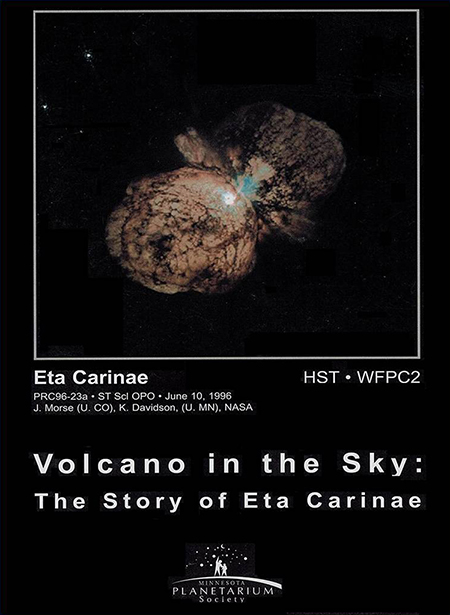Cosmic Curiosities
“Why should I feel lonely? Is not our planet in the Milky Way?”
- Henry David Thoreau, American naturalist and writer
A Supernova Story
Years back, I was working with Roberta Humprheys, an astronomer at the University of Minnesota. She was helping me make a short movie called Volcano in the Sky: The Story of Eta Carinae. Eta Car (its nickname) is a massive star. One day soon, it will go supernova and become amazingly bright in Earth’s night sky (“soon,” astronomically speaking, means this could happen tonight or in 10,000 years, give or take). Dr. Humphreys described how Eta Car is like a volcano; it erupts periodically, but doesn’t completely die. After one outburst in 1843, this unstable star became the second brightest in the sky. Since then, it varies in brightness. Today, Eta Car shines as a fainter star in the southern hemisphere sky. It is not visible here in Wisconsin.
Between camera interviews for Eta Car’s amazing story, Dr. Humphreys and I discussed other stars that might go supernova “astronomically soon” in our skies. We talked of Betelgeuse, of course, the bright red giant star in the constellation of Orion. Betelgeuse recently had some outbursts that dimmed the star. But as those clouds expanded and faded, the star became bright again.
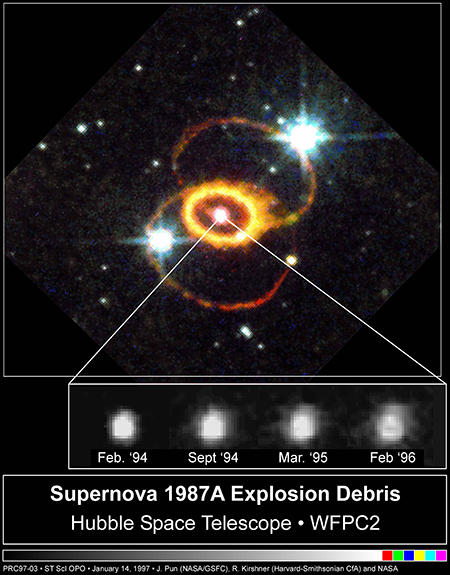
We chatted about a recent supernova—1987A. It was the nearest supernova to Earth in almost 400 years! It wasn’t located in our Milky Way galaxy, but a small neighboring galaxy called the Large Magellanic Cloud. This increased distance meant that, when 1987A was first seen, it wasn’t all that bright in the sky. It peaked at magnitude 3—as bright as Megrez, the faintest star in the Big Dipper. Since Betelgeuse and Eta Car are much closer, being located in our Milky Way galaxy, they will shine even brighter than the planet Venus. This will only last for a few months as the supernova debris field expands and dissipates.
Dr. Humphreys told me they had an eye on a 1987A, a blue giant star, before 1987. They knew it was massive—churning out 100,000 times more energy than the sun—and might explode soon. Giant stars like 1987A live their life in the fast lane, living only millions of years. She could tell the star was getting near the end of its life by analyzing its spectral light. By breaking apart a star’s photons, astronomers can tell the composition of a star, its temperature, and distance, and roughly estimate its age.
Actually, the stellar death of Supernova 1987A did not take place in 1987; it occurred back in 158,000 BCE. The distance to the Large Magellanic Cloud galaxy is 160,000 light years. So the exploding light has been racing across space for thousands of years to finally reach Earth on February 23, 1987—35 years ago!
Images over subsequent years have revealed dynamic stellar debris rings surrounding 1987A. Hubble observations show this hot gas shell sweeping outward toward previous matter ejected by the star thousands of years before it exploded. These collisions brighten the rings over the years.
Why are stars and supernovae essential? As Dr. Humphreys emphasized in our film, “Carbon makes up most of our bodies. It came from inside a star. It’s created there where the nuclear reactions are going on. So how did that stuff get out? How did it get in us? Well, it got created in a very massive star like Eta Car that eventually does explode.”
1960s Space Ride

Sixty years ago, on February 20, 1962, astronaut John Glenn became the first American to orbit the Earth. Aboard the Mercury capsule Friendship 7, Glenn’s space trip made him an instant hero. The United States was catching up to the Soviet Union in the race to the moon. John Glenn would fly into space again in 1998 aboard the space shuttle Discovery.

John Glenn (Glen Powell) meets mathematician Katherine Johnson
(Taraji P. Henson) in the film Hidden Figures, 20th Century Fox
Glenn obviously needed a lot of help getting into space for his historic journey. The book and movie Hidden Figures is an inspiring story that looks behind the scenes at America’s early space adventures.
Around the World with the Milky Way
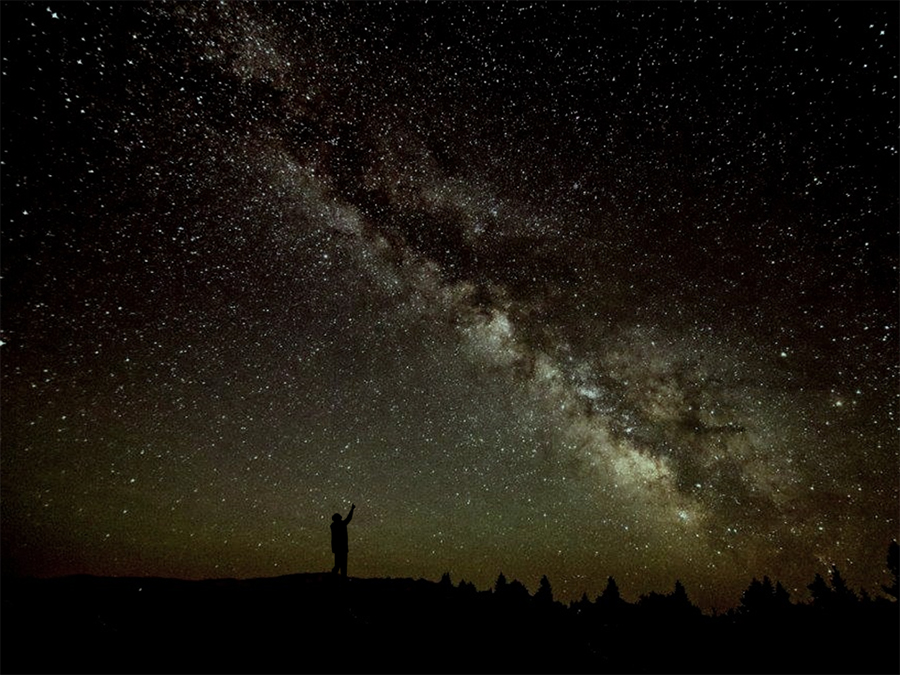
It shines like a faint ribbon of milky light, weaving its way through the stars. Its exquisite soft glow against the darkness of night sky, arching high above our heads, has captured our imaginations for generations. We now know that this band of light is one of the spiral arms of our amazing Milky Way galaxy. We live here. Our sun is part of this huge family of stars.
In modern times, however, observing the Milky Way’s glow has become elusive. It’s still there, beckoning. One just needs to find a dark and clear night far away from the city lights.
The Milky Way is the name we get from the Ancient Greeks. They believed the soft white light was the Goddess Hera, spilling her milk that was meant for an infant Hercules. If we travel to Mexico, the Maya would call it the World Tree. Over in Japan, it’s a silver river full of fish, swimming away from the crescent moon which was a fisherman’s hook. Aboriginal Australians saw an emu protecting its eggs under a tree from a possum. And for the Cherokee, it’s a startled Spirit Dog leaping into the sky, leaving a trail of cornmeal he was eating.
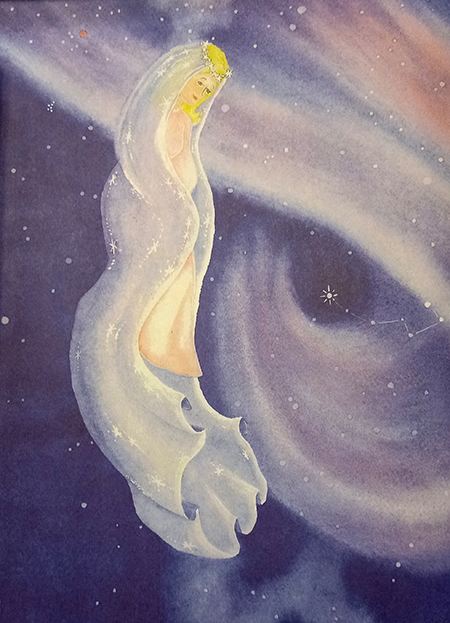
In the small northern European country of Estonia, they saw the Milky Way as a wedding veil. Their tale starts with Lindu, Queen of the Birds, overseer of all bird’s migrations. She had many suitors, the North Star, the Moon, the Sun… but she turned them all down. They were too steadfast in their ways and not very interesting to her. One day, a new suitor appeared at her door. He flowed in and out of the sky as he pleased, varying not only in brightness, but vibrant color as well. Lindu was enchanted with these Northern Lights. She agreed to marry him. She prepared herself by making a soft, beautiful bridal veil. When the day of the wedding came, the Northern Lights were nowhere to be found. Poor Lindu fell into despair and began neglecting her duties and the birds. The arctic loon, the northern lapwing, and the arctic tern all flew around in confusion, unsure of where to go.
Lindu’s father, Uko, was the King of Heaven and couldn’t bear to see his daughter suffer. He asked the winds to sweep her up into the sky. Lindu found joy again up in the sky, taking care of her beloved birds. She still wears her wedding veil as a reminder, its fabric fluttering against the night sky. Sometimes in the winter skies, the Northern Lights appear again, and Lindu is reunited with her fiancé once more.
Estonia is not the only place to have a romantic story tied to the heavenly Milky Way. You can experience other passionate stories from South Africa to China. All stories, though, reveal how the Milky Way inspires our hopes and dreams. So, find your own place far from the city and gaze upon a dark, clear sky. See what stories you might find from the beautiful milky light arching across the sky. The limit is only your imagination!
Space in Sixty Seconds
Delve deep into the Orion Nebula, a stellar nursery more than 1,000 light years from Earth.
Sky Sights
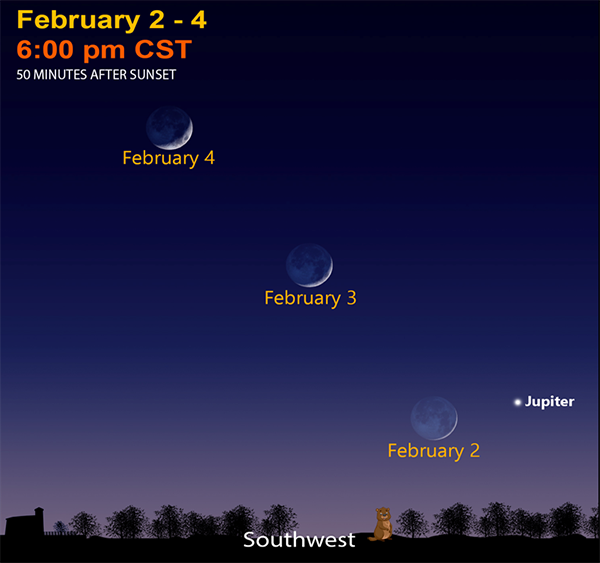
Jupiter is the only planet left shining in the evening sky this month. At February’s start, the largest planet will be easily seen, especially with the Moon orbiting by from February 2-4. By the last week in February, Jupiter is too close to the sun and can’t be seen.
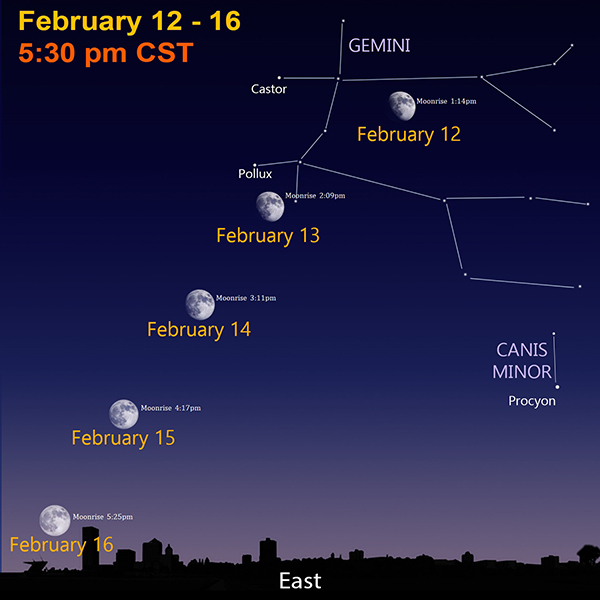
Watch the waxing gibbous Moon shine brighter and brighter from February 12-16. The full moon on February 16 is often called the Snow Moon, Storm Moon, or Hunger Moon.
Around 1930, the Farmer's Almanac in Maine started referring to the full moons in each month using Native American names. Lately, they have become very popular. These descriptive moon names usually come from nature. For example, in the northeast there are lots of snow storms in February, thus the Snow Moon or Storm Moon. This tough, cold weather can also make hunting difficult, meaning less food to eat, thus the Hunger Moon.
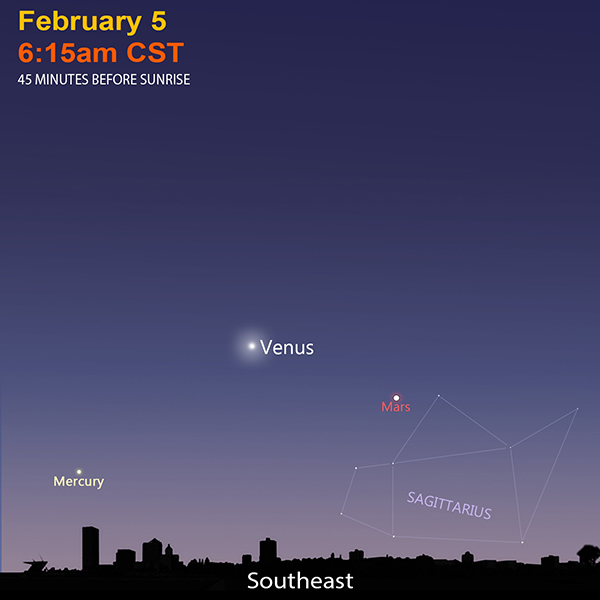
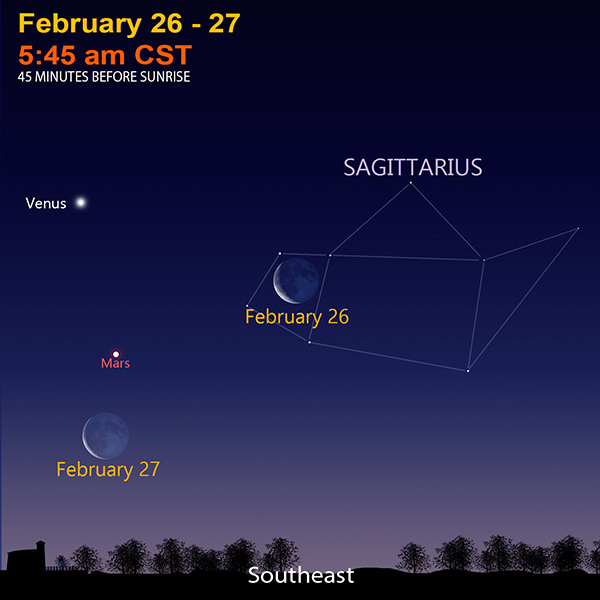
Venus, Mars, and Mercury are all visible in the morning sky in early February. Of the three rocky planets, only very-bright Venus will be easy to observe. By month’s end, Mercury is too hard to see, but the waning crescent Moon helps you find Venus and Mars.
Saturn is at solar conjunction, behind the sun, on February 4. The ring world moves into and will be easily seen by the end of March.
February Star Map
Sign Up
Receive this newsletter via email!
Subscribe
See the Universe through a telescope
Join one of the Milwaukee-area astronomy clubs and spot craters on the Moon, the rings of Saturn, the moons of Jupiter, and much more.
Follow Bob on social media
Twitter: @MPMPlanetarium
Facebook: Daniel M. Soref Planetarium


